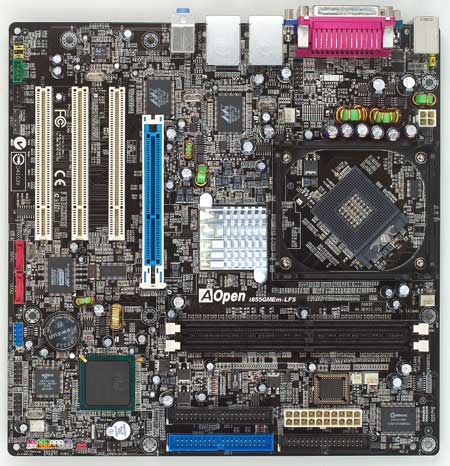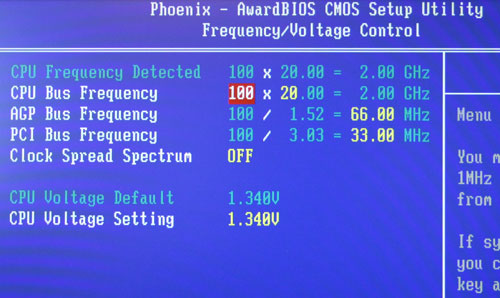Intel's Pentium M on the Desktop - A Viable Alternative?
by Anand Lal Shimpi on February 7, 2005 4:00 PM EST- Posted in
- CPUs
The Motherboards
As we mentioned before, both AOpen and DFI are currently shipping Pentium M desktop micro ATX motherboards based on Intel's 855GME chipset.AOpen
The AOpen GMEm-LFS is a micro ATX board based on the 855GME chipset, with integrated graphics support as provided by the chipset.
AOpen outfitted the board with dual GigE ports, both of which are placed on the back I/O panel above the four USB 2.0 ports.
The board only requires a 20-pin ATX power connector and a 4-pin +12V auxiliary connector like older Pentium 4 motherboards, although you can use a newer 24-pin PSU if you'd like.
Since AOpen uses ICH4-M, only parallel ATA is supported, so AOpen outfitted the board with a Promise SATA RAID controller to drive the two SATA ports on the board. AOpen also placed an Agere FireWire 400 controller on the board; however, they didn't supply the bracket to actually take advantage of the two ports supported by the controller.
The BIOS setup of the GMEm-LFS is pretty straightforward, although we definitely appreciated the layout of the overclocking options. The only complaint we had was that memory dividers weren't explicitly listed, which requires some math on the user's part to make sure that they're selecting the right memory speed when overclocking. The only voltage adjustments present on the board are for Vcore, which unfortunately tops out at 1.340V.

We had pretty decent overclocking success with the AOpen board and our Pentium M 755 (2.0GHz). Running it at 133MHz (533MHz FSB) x 18 at the maximum core voltage of 1.340V proved to be quite stable in all of our benchmarks. We could get the Pentium M to POST at 2.53GHz, but it wasn't stable enough to run our benchmarks.
Unfortunately, the biggest problem with overclocking the AOpen (as well as the DFI) board was that you could hardly overclock the memory bus. Regardless of what type of DDR400 memory we used, the highest that we could get the memory bus to run (stable) was 355MHz using the 4:3 memory divider.
Given how bandwidth-starved the Pentium M is, we were hoping for better overclocking success in the memory department, but were met with disappointment. The problem appears to be related to the 855GME chipset, as the DFI board suffered the same fate as the AOpen board.
So, while there's headroom in the CPUs (even our 1.7GHz Pentium Ms had no problems running above 2.0GHz), it seems like the chipsets/motherboards will limit the extent to which you can overclock.
The AOpen GMEm-LFS currently sells for $230.










77 Comments
View All Comments
bobsmith1492 - Monday, February 7, 2005 - link
Granted the T8000 here is an Intel fanboy, but please notice Anand was comparing clock-for-clock.T8000 - Monday, February 7, 2005 - link
There is one big difference between this review and the reviews where the Pentium M did very well: CLOCKSPEED!While others where able to get over 2.8 Ghz with aircooling, Anand got just 2.4 Ghz. This may be a coincidence, but it is the difference between surprisingly good performance and a few % below others.
As most of the benchmarks where based on the stock 2 Ghz, the difference became even greater.
So this review just shows that the stock speed Pentium M performs about 30% less with about 30% less clockspeed than overclocked versions.
A slightly redesigned version with higher voltages is not extremely unlikely to hit at least 3 Ghz. Combining that with a desktop chipset will result in stellar performance, as the benchmark scores in this review (x1.5) indicate.
But since there is no slightly redesigned version and Intel has no good reason to make one, the current Pentium M desktops will only appeal to overclockers and silent computing people.
Also, for some reason, Anand found the 90W TDP of the 2.4 Ghz A64 closer to the 20W of the P-M than to the 110W of the 3.8 Ghz P4.
CSMR - Monday, February 7, 2005 - link
That's a very good option Zebo, thanks for posting it.teutonicknight - Monday, February 7, 2005 - link
One suggestion: Why don't you start using a newer version of Premiere for testing? I personally don't use it, but every that I know who does says before Premiere Pro, the program sucked. I'm sure the render results would be much more realistic and accurate if you used a more up to date version of the programRegs - Monday, February 7, 2005 - link
I was wondering the same thing too Jeff. If you feed it more bandwidth, it would eliminate the pipeline stalls and maybe give it a chance to reach higher clock speeds. Right? Or is it still prohibited by the shorter pipeline to reach higher clock speeds?Longer pipeline = wasted clock cycles. But to me that sounds like the PM should actually scale a lot better with a speed boost. Why exactly does it scale badly compared to a P4? Could it be remedied in anyway with a dual channel memory bus?
ozzimark - Monday, February 7, 2005 - link
there's something wrong with the 3400+ in the spec tests. why is the 3000+ beating it consitantly?Warder45 - Monday, February 7, 2005 - link
Maybe I missed something but I don't see the reason for all the negitivity in the final words. The 2.4Ghz P-M was very close to the A64 2.4Ghz in many of the tests, 3D rendering seemed to slow it down but that looked like it. With better boards and memory the P-M might best the A64 in a clock for clock match up.I do agree the prices are way too high. I think Intel really needs to wake up and smell what they have cooking here. With more support and more aggressive priceing they could easily have a winner in the HTPC and SFF markets.
plewis00 - Monday, February 7, 2005 - link
Surely when someone builds a mainboard with the Sonoma (i915) platform using PCI-E and DDR2-533 then it will change. And I wouldn't have thought that's that far off assuming they don't charge rip-off prices for the technology. It would also be perfect for Shuttle systems where the emphasis is on quietness and coolness rather than so much on performance.Zebo - Monday, February 7, 2005 - link
CSMRSo's this one very soon..
http://www.xtremesystems.org/forums/showthread.php...
...more than excellent performance wise if Dothan is excellent...power differential hopefully for AMD will be nominal.
Sokaku - Monday, February 7, 2005 - link
While it is true that the A64 has way more bandwidth, I doubt that is the reason why it crushed the P-M in the Professional Applications. I think the real cause is to be found in the P-M's abillity to do FP divisions. The P-III had a pipelined FP unit, however div operations were extremly expensive. My guess would be that Intel haven't thrown much effort into improving on this.